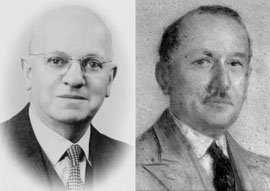

baume & mercier
Historique de la maison d'horlogerie Baume & Mercier
L’alliance fondatrice remonte à 1830 : Louis Victor et Pierre Joseph Célestin Baume fondent ensemble la société « Frères Baume » enregistrée au village de Bois dans les Franches-Montagnes du Jura Suisse. Soucieux d’avoir de bons horlogers, ils commencent par les former, contribuant ainsi à introduire l’horlogerie dans leur district. Visionnaires quant à l’évolution de la montre en général et intransigeants sur la réalisation de montres traditionnelles de grande qualité, ils choisissent de s’installer dans une grande capitale européenne, Londres, et créent en 1851 Baume Brothers, qui développe avec succès les marchés anglais, écossais et irlandais puis ceux australiens et néo-zélandais.
C’est en 1920 que l’alliance Baume & Mercier prend naissance. Sur le modèle d’une direction bicéphale qui a fait ses preuves chez Baume, Baume & Mercier naît de la rencontre de deux hommes, William Baume, troisième fils d’Alcide Eugène et petit-fils de Louis-Victor, et Paul Mercier, en 1912.
D’origine russe, Paul Tchereditchenko (dit Mercier) est un homme raffiné, enthousiaste, passionné par les affaires, très attiré par les arts et ami de nombreux peintres. William, lui, est un homme de mesure, de rigueur très attaché à la réputation de son nom. De leur complémentarité – William en charge des aspects techniques et Paul de la partie commerciale – naîtra, une association le 26 novembre 1918 et une marque « Baume & Mercier Genève » déposée le 27 août 1920.
Durant les années 1920 à 1930, Baume & Mercier s’impose sur les cinq continents. Hélas atteint par la maladie, William Baume doit bientôt se retirer.
En 1937, au départ de Paul Mercier, un homme au fort charisme prend place au conseil d’administration : Constantin de Gorski. D’origine polonaise, cet homme hors du commun, brillant, cultivé et artiste insuffle à Baume & Mercier un esprit moderniste.
Pendant la deuxième guerre mondiale, Marc Beuchat et Renée Juillerat viennent renforcer le conseil d’administration et se révèlent des collaborateurs de premier ordre, selon les dires de William Baume.
En 1964, la lettre grecque Phi devient le symbole de la marque et apparaît sur tous les cadrans des montres Baume & Mercier
En 1963, la maison d’horlogerie intègre PBM international, un groupe spécialisé dans la production et la distribution de l’horlogerie de luxe, qui ,en 1988, est acheté par la compagnie financière Richemont.
En mars 1993, cette dernière décide de créer le groupe Vendôme afin de séparer ses secteurs de luxe du reste de ses activités.
Aujourd’hui, Baume & Mercier fait partie intégrante du groupe Richemont aux côtés de marques prestigieuses comme Cartier, Piaget, Vacheron Constantin, Jaeger LeCoultre…
Founding alliance in 1830: Louis Victor and Pierre Joseph Célestin Baume created and registered the « Frères Baume » trading entity in the village of Les Bois in the Swiss Jura. Anxious to employ only skilled watchmakers, they trained each one and in so doing helped to establish the profession in their region. Visionaries as to how the watch would evolve in general and uncompromising in their demand for fine quality traditional watches, they decided to set up business in a major European capital. They chose London and in 1851 founded Baume Brothers. After successfully developing the company on the English, Scottish and Irish markets they broke new ground as far afield as Australia and New Zealand.

Birth of the Baume & Mercier alliance in 1920. In 1912, the “two-headed” management system that had already proved its worth at Baume was repeated and Baume & Mercier was born of the encounter of two men: William Baume, third son of Alcide Eugène and grandson of Louis-Victor, and Paul Mercier.
Of Russian origin, the elegant and enthusiastic Paul Tchereditchenko (known as Mercier) possessed an insatiable appetite for life, business and the arts. His circle of friends included numerous painters and writers. William, on the contrary, was a man of moderation and rigorous discipline who was fiercely attached to his family’s name and reputation. Making the most of William’s technical expertise and Paul’s sharp business insight, the well-balanced association was concretized on 26 November 1918 and the « Baume & Mercier Genève » trademark was registered on 27 August 1920.
Throughout the 1920s and 1930s, Baume & Mercier imposed itself on five continents. Unfortunately, poor health obliged William Baume to retire from the company soon after.
In 1964, the Greek letter Phi was adopted as the brand’s emblem and is a distinctive feature on all Baume & Mercier watch dials.
In 1963, the watchmaking house became part of PBM international, a group specialized in the production and distribution of luxury timepieces, which was bought over by the Richemont financial structure in 1988.
In March 1993, the latter decided to create the Vendôme group in order to separate its luxury sectors from the rest of its activities.
Today, Baume & Mercier is an integral part of the Richemont group alongside other prestigious brands such as Cartier, Piaget, Vacheron Constantin, Jaeger LeCoultre…